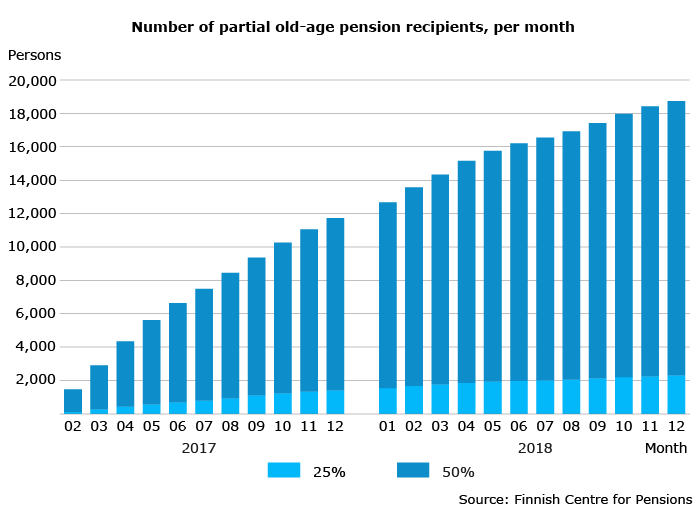Every tenth 61-year old chose the partial old-age pension

During its first two years, 23,000 persons (10,300 in 2018) chose to take payment of the partial old-pension. Nearly 90 per cent selected to take out the maximum amount, or half of their earned pension pot. On average, they were paid 790 euros per month. Recent statistics of the Finnish Centre for Pensions reveals that the monthly pension of those who have taken out a partial old-age pension at age 61 will be permanently reduced by roughly 110 euros when they retire on a full old-age pension.
The partial old-age pension replaced the part-time pension in the 2017 pension reform. This pension option became available to all 61-68-year-olds, which caused the number of starting pensions to rise. 2018 was the first year in which only one age group reached the age that qualifies for this pension benefit.
“On average, 900 people applied for the pension per month in 2018. The situation has stabilized although the number of persons who get a partial old-age pension keeps growing. At year-end 2018, they numbered nearly 19,000,” says development manager Jari Kannisto of the Finnish Centre for Pensions.
Deduction for early retirement not a problem
Every tenth of those who have taken payment of the partial old-age pension have done so more-or-less as soon as they have turned 61 years. At year-end 2018, nearly 90 per cent of the persons who took payment of the partial old-age pension took out 50 per cent of their earned pension pot. The average monthly partial old-age pension was 790 euros (877 euros for men and 662 euros for women). Roughly 57 per cent of the recipients of this pension benefit were male.
The partial old-age pension, when taken out early, reduces the full old-age pension amount permanently. In 2018, roughly 9,800 persons took payment of the partial old-age pension early. Around half of them had turned 61 years (born in 1957). That means they took out their pension nearly three years early. On average, their monthly old-age pension will be 110 euros smaller when they retire on a full old-age pension.
”Although the deduction for early retirement reduces the pension of the youngest with more than 100 euros per month, the strong interest in this pension benefit persists. By working past their retirement age, they can offset the reduction. At this point we don’t know how many will actually do so,” Kannisto explains.
Twenty new retirees on a years-of-service pension in 2018
In addition to the partial old-age pension, the 2017 pension reform introduced the years-of-service pension for persons who whose work has required great mental or physical effort. The first years-of-service pensions were paid out in the spring of 2018. That year, a total of 21 persons got the years-of-service pension. Only one of them was female. The average monthly years-of-service pension was 1,980 euros. At year-end, five people were still getting the years-of-service pension.
In 2018, years-of-service pensions were paid for no more than three months since one of the requirements is that the recipients have turned 63 years. The pension ends when the recipients reach their retirement age. In the future, as the retirement age rises, the time spent on a years-of-service pension will become longer, which may make the benefit more popular.
Two out of three years-of-service pensions were granted based on musculoskeletal diseases.
“The law states that the pension can be granted also based on work that requires great mental effort. However, so far all years-of-service pensions have been granted based on work that requires great physical effort. Perhaps we’ll see a change in the situation once the number of people getting a years-of-service pension increases and the range of different working lives expands,” Kannisto estimates.

The partial old-age pension
- replaced the part-time pension in the 2017 pension reform;
- offers the possibility for 61-year-olds or older to take out a quarter (25%) or half (50%) of the pension pot they have earned so far;
- permanently reduces the full old-age pension by 0.4 per cent for each month that the pension is taken early;
- can be taken out after reaching the retirement age. If the partial old-age pension is taken late, it is increased by 0.4% for each month that it is deferred;
- does not limit how much the pension recipient can work or earn. They can be unemployed or work while drawing the pension.
The years-of-service pension
- requires that the recipient is 63 years old (born in 1955 or later);
- can be granted if the person has done work that requires great mental or physical effort for at least 38 years;
- requires a medical statement that the ability to work has been reduced;
- amounts to the pension pot that the recipient has earned up to the time they take payment of this pension; and
- is paid until the recipient reaches their retirement age.
New pension benefits (Etk.fi website)
More information
Jari Kannisto, Development Manager, +358 29 411 2232, jari.kannisto(at)etk.fi
Photo: Gettyimages